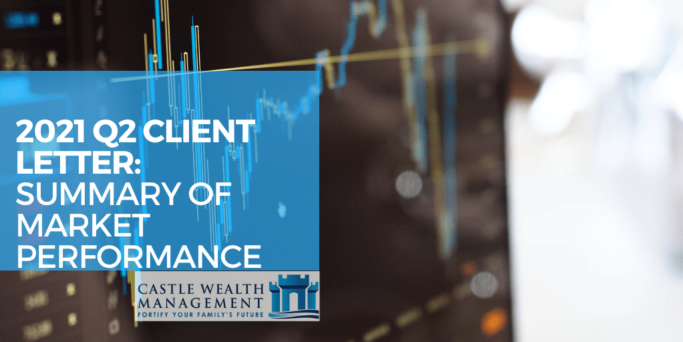Summary of Market Performance
Second Quarter Ended June 30, 2021
U.S. Equity Investment Environment
Despite inflation concerns and uncertainty over the future course of the Fed’s stimulus efforts, stocks continued higher as the S&P 500 recorded five new monthly closing highs in a row. The S&P 500 rose 8.6% in the quarter, ticking its fifth consecutive monthly rise. Mid way through the second quarter, the value/growth paradigm among large and mid-cap stocks flip-flopped and growth stocks outperformed by a wide margin in June (value continued to dominate small cap performance.) With respective returns of 11.6% and 10.7%, the S&P 500’s information technology and communications services sectors contributed 3.1 and 1.2 percentage points to the S&P 500’s second quarter’s advance. Energy, the benchmark’s third best performing sector, up 11.3%, only added 0.32 points due to its small weight in the index. The S&P MidCap 400 and Russell 2000 were up 3.6% and 4.3%, respectively, in the quarter. Despite second quarter underperformance, mid- and small caps have outperformed the S&P 500 over the six months with returns of 17.6% for the S&P MidCap 400 and 17.5% for the Russell 2000, ahead of the 15.3% for the S&P 500.
International Equity Environment
Equity gains were widespread outside the U.S. with the MSCI EAFE Index of developed markets and the MSCI Emerging Markets Index both up 5%. Gains were widespread across Europe. Switzerland and France, up 11.5% and 9.1% respectively, accounted for the biggest positive contributions to the MSCI Europe Index that rose 7.8% in the quarter. As in the U.S., value/dividend stocks led Europe’s market higher until mid-June when growth stocks dominated. Japan dragged the MSCI EAFE index lower with its -0.3% return while the UK’s 6.0% advance was additive to the benchmark’s gains largely due to the performance of the financial sector. Among emerging markets, Latin America led with its 15.0% second quarter gain. Brazil’s 22.9% and Mexico’s 9.1% returns accounted for the region’s outperformance. The seven Emerging Asia countries rose 3.8% in aggregate, led by India and Korea, up 6.9% and 4.8%, respectively.
Fixed Income Environment
Marking a reversal from the first quarter’s sharp rise, the yield curve flattened as long-term interest rates fell in the second quarter over renewed doubts about sustained inflation and economic growth. The 30-Year Treasury bond ended the quarter yielding 2.06%, compared to 2.40% at the end of March and 1.65% at year-end 2020. The 10-Year Treasury ended the quarter yielding 1.45%, versus 1.74% on March 31st, and higher than its 0.93% yield on December 31st. As bond prices move higher when yields decline, lower interest rates led to positive returns in the quarter, but higher yields since the beginning of the year left most bond sectors in the red year-to-date. Led by long-term maturities where yields fell the most, both U.S. Treasuries and corporate bonds rose 6.5% in the quarter but ended the six months with losses of -7.9% and -2.5%, respectively. Riskier high-yield bonds finished the quarter up 2.7% and produced a six-month gain of 3.6%. The Bloomberg Barclays U.S. Aggregate index finished the first quarter with a gain of 1.8%, versus -1.6% for the six months.
Commodities Environment
Many commodity prices that had risen for months on the back of the economic re-opening had a lackluster quarter based on the notion that commodity prices and supply/demand will normalize over time. Lumber prices ended the quarter 55% off May highs, and Gold sold off after the June FOMC meeting but finished the quarter up 3.2%. Brent crude closed the quarter at $75.13 a barrel. Marked by volatility, the GSCI was up 12.8% in the quarter to finish the six months up 23.3%.

